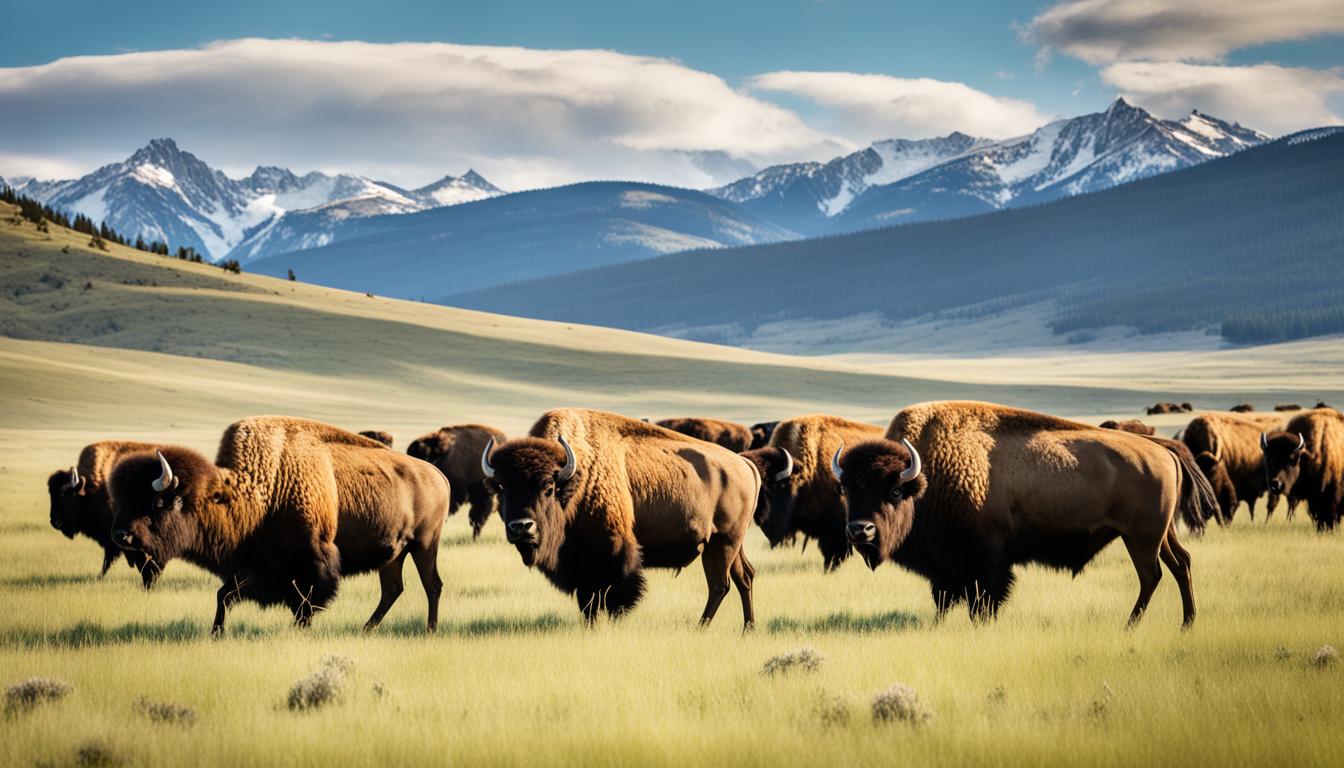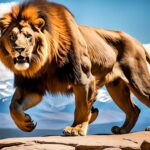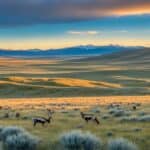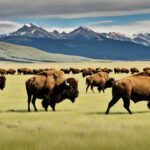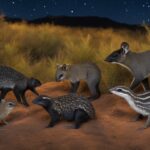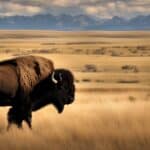The bison, a true symbol of the untouched American wild, used to cover the land in huge numbers. But do they still live free today?
There were about 60 million of these animals, once making up a vital part of the landscape. Sadly, their numbers fell because of excessive hunting and diseases from cows. But today, thanks to strong efforts to save them, bison can be found in the wild, with about 31,000 living in the USA, Canada, and Mexico.
There are two types: the plains bison and the big wood bison. Their revival shows the success of conservation and remains a key part of America’s story.
Introduction to American Bison
The American bison, scientifically known as Bison bison, is a key part of the USA. It nearly went extinct but fought back. The bison shaped land and lives in both historical and cultural ways.
History and Significance
The American bison once lived across big parts of North America. It was essential for many Native American tribes, providing food, clothing, and more. Efforts to save them are part of saving American heritage. The bison now stands for resilience and protecting nature.
Cultural Importance to Native Americans
The bison is extremely important to Native American peoples. It’s more than food; it symbolizes their culture and spirituality. Bisons feature in ceremonies and everyday life, showing the tribes’ strength. Restoring bison helps renew important ties between tribes and their iconic animal.
Current Status of Bison Populations in the USA
The bison population in the USA has come a long way since the 1800s. Back then, their numbers were in serious decline. Thanks to hard work and dedication, bison numbers have gone up again. This includes areas like national parks and private farms. In 2016, the bison became the national mammal of the USA. This shows how important they are to us and our history.
National Parks and Reserves
Many bison now live in national parks and reserves managed by the Department of the Interior. These include places like Yellowstone and Wind Cave. It’s estimated that a third of all wild bison in North America live on these lands. This is great for the bison and helps their gene pool stay diverse.
Bison also find a safe haven at the National Bison Range. These protected areas are very important for keeping bison safe and healthy.
Conservation Lands and Private Reserves
Private lands also play a key role in bison conservation. With the help of groups like the American Bison Society, many private farms now have bison herds. This not only helps with bison survival but also teaches people about the importance of these animals. It’s a win for nature and for everyone who enjoys learning about the wildlife in our country.
Wild Bison USA: Where to Find Them
If you’re wondering where to see bison in the wild, the USA has great places. Majestic bison roam freely in several key spots. Seeing them in their natural homes gives you a special look at America’s wildlife. You get a unique glimpse into nature and the country’s history.
Yellowstone National Park
Yellowstone is famous for its bison. It is a must-visit for those who love wildlife. The Yellowstone National Park bison have been here for a long time. Since ancient times, they’ve called this place home. It’s a special chance to see the country’s biggest public bison herd up close.
Wind Cave National Park
Wind Cave National Park in South Dakota is a great place to see bison. The park’s bison help in conserving this species. They’ve supported bison repopulation in various places. Here, you can see bison move freely in the park’s lush lands.
National Bison Range
President Theodore Roosevelt started the National Bison Range in Montana. It’s among the United States’ oldest wildlife refuges. This sanctuary is a safe place for bison. It lets people see them in a natural space. This shows how bison’s wandering is crucial.
Bison Conservation Efforts in the USA
Bison conservation efforts in the USA are making a big difference. They are bringing bison back to many places in the country. These efforts are a team job, with both groups and governments working hard.
The American Bison Society’s Role
The American Bison Society plays a big part in saving bison. Thanks to leaders like President Theodore Roosevelt, they focused on raising and putting bison back in their homes. This helped bring bison back into the wild, where they belong.
Government and Tribal Efforts
Government programs and tribal projects are also crucial. They help take care of bison by giving money and what’s needed to save their homes. Tribal projects join saving bison with honoring their history. Joining their methods with science makes bison care better for everyone.
American Bison Habitat and Range
The American bison lives in varied places, adding life to different ecosystems. Their homes show how they fit well into nature and are very important. They live across different landscapes, proving their role in diverse ecosystems.
Grasslands and Prairie Ecosystems
The bison’s home was once the vast grasslands and prairies of North America. These areas were vital for their life, giving them all they needed to eat and grow. Bison eating grass actually helps native plants to grow, which is great for other animals that live there.
Adaptation to Different Environments
Bison have amazed us with how they can adapt to different places. Even though they love wide open spaces, they can also live in the woods. Their ability to adjust to new places has been key to their survival, allowing them to live in vast areas from east to west.
Nowadays, we work hard to keep these places safe for bison, so they can always have a home. Conservation efforts are focused on making sure bison have places where they can flourish, no matter the environment.
Are There Wild Bison in the USA?
Yes, the USA has wild bison living in protected areas. Seeing these majestic animals in the wild shows conservation success. They live in various places where you can see them naturally.
Yellowstone National Park stands as a top place for wild bison. It has huge herds that freely roam. You can also visit the National Bison Range, a special spot for bison preservation and research.
Wind Cave National Park in South Dakota is another home for them. These places are more than just for visiting. They’re important for keeping bison safe. This means we can continue to see these iconic animals in the years to come.
| Location | Notable Feature | Population |
|---|---|---|
| Yellowstone National Park | Largest continuous population | 4,800 bison |
| National Bison Range | Dedicated preservation area | 500 bison |
| Wind Cave National Park | Unique prairie ecosystem | 400 bison |
If you’re interested in seeing wild bison, these places are great. By visiting them, you help keep bison populations strong. It’s a way to support the bison’s story of survival and thrive.
The Role of National Parks in Preserving Bison Populations
National parks are key in keeping bison safe and letting them grow in numbers. Here, these mighty animals are protected, so you can see them freely. This helps keep bison strong and varied.
Yellowstone National Park’s Unique Contribution
Yellowstone is a top place for bison care. It’s the main spot where bison have always been since forever. This long history there adds a lot to bison’s gene pool.
Other Prominent National Parks
Not just Yellowstone, but places like Wind Cave and the National Bison Range are crucial. They keep bison safe and help them grow in number. When you visit, you help keep this part of America’s nature alive.
- Yellowstone National Park: Home of bison since ancient times, boosting their genetic mix.
- Wind Cave National Park: Big help in getting bison back in other places.
- National Bison Range: Started by Theodore Roosevelt, it’s key in bison care.
National parks are vital in protecting bison. They make sure these amazing animals are around for the future. Bison are a big part of America’s nature and history.
Where to See Bison in the Wild in North America
North America is a prime spot for seeing bison in their natural element. Many locations across the continent offer tours to witness these impressive animals up close.
Best Places to Observe Free-Roaming Bison
When looking for the best places to see wild bison, check out these standout spots:
- Yellowstone National Park: It’s home to a huge number of bison. You can see them living freely in their native environment here.
- Antelope Island State Park: Found in Utah, this park not only has roaming bison but also beautiful views.
- National Bison Range: Located in Montana, this reserve is known for its role in bison conservation and great bison viewing.
Safety Precautions When Viewing Bison
It’s vital to observe bison from a safe distance. Follow these safety steps for a pleasant viewing experience:
- Always stay at least 300 feet away from bison to keep safe.
- Using binoculars or a telephoto lens lets you get a close-up view without getting too close.
- Stick to marked viewing spots and listen to park rules and advice from the experts.
- Don’t try to feed or get near bison. Remember, they’re wild and might act unexpectedly.
| Location | State | Unique Features |
|---|---|---|
| Yellowstone National Park | Wyoming, Montana, Idaho | Largest public bison population, geothermal features |
| Antelope Island State Park | Utah | Scenic views, proximity to Great Salt Lake |
| National Bison Range | Montana | Conservation efforts, diverse wildlife |
Differences Between Plains Bison and Wood Bison
Plains Bison and Wood Bison are two types of bison in North America. Each one is special, with unique looks and ways of acting. They adapt differently to their homes, which makes them stand out from each other.
Physical Characteristics
Wood Bison are usually bigger than Plains Bison. Their shoulders can be up to 6.6 feet tall, and they may weigh 2,200 pounds. On the other hand, Plains Bison stand about 5 to 6 feet at the shoulder and can weigh up to 2,000 pounds.
The difference in size is not the only thing that sets them apart. Wood Bison have a larger, square-shaped hump, while Plains Bison’s humps are smaller and rounder. Wood Bison also have darker and coarser fur, especially around their necks. This type of fur helps them hide well in the forests where they live.
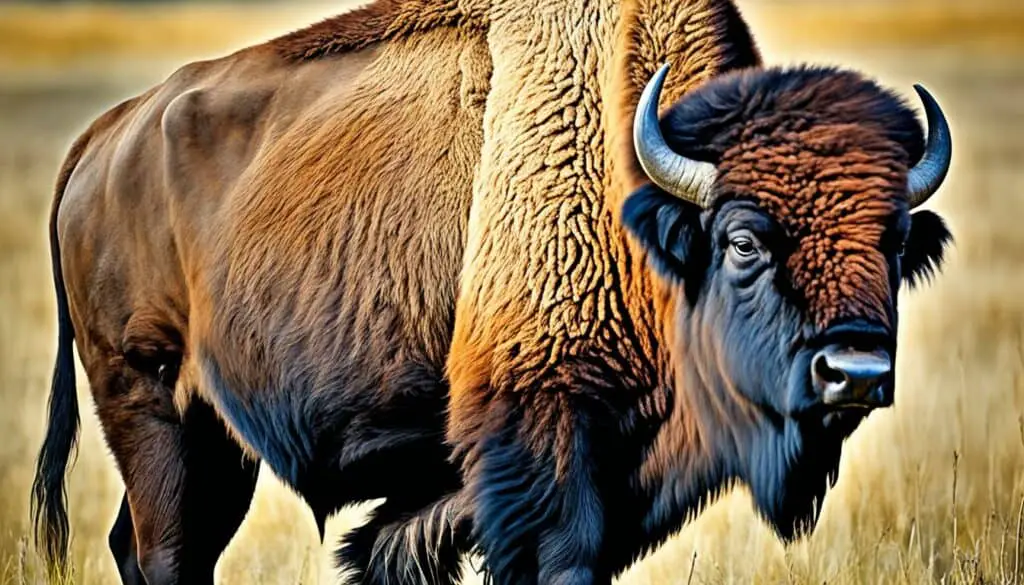
Behavioral Differences
Plains Bison like wide-open spaces and eat from grasslands. They travel in big groups and are always looking for new food spots. This keeps the grasslands healthy where they live.
Wood Bison, however, choose forested and swampy areas for their home. They move less and feed in smaller groups than Plains Bison. Knowing about these different behaviors is important for protecting both types of bison and studying nature.
| Characteristics | Plains Bison | Wood Bison |
|---|---|---|
| Habitat | Grasslands | Woodlands, swampy areas |
| Size | Up to 6 feet tall, up to 2,000 lbs | Up to 6.6 feet tall, up to 2,200 lbs |
| Hump Shape | Rounded | Square |
| Coat | Less shaggy, lighter | Shaggier, darker |
| Social Behavior | Larger herds, more mobile | Smaller herds, more sedentary |
Bison as a Symbol of American Heritage
Bison are key to the spirit and strength of America. Chosen as the national mammal, they showcase the country’s natural power. Their comeback from almost disappearing shows hope and the success of protecting our wildlife. This story highlights the important role they play in America’s heritage.
National Mammal Designation
In 2016, the bison became the national mammal of the United States, marking it as an icon of conservation. This shows how important they are in keeping our environment balanced. Recognizing the bison’s past and future is a major step in protecting them for all to enjoy.
Role in American Identity and Conservation Stories
The bison is more than just a big animal. It embodies the never-give-up attitude of the American people. It was important to Native Americans and remains a symbol of strength today. By celebrating the bison, we honor our history and commit to its survival.
Support for bison also mirrors our care for the Earth. The fact that bison are thriving again tells a story of hope in preserving our planet. It’s a success story for environmental icons that shows how tradition and science can work together well.
Challenges and Future of Bison Conservation
The journey for bison to come back in North America shows how much effort went in. But, bison conservation still faces big challenges. Keeping the bison’s genetic diversity is key to their health. It stops problems like inbreeding and keeps the species strong.
Also, bison need wide areas to roam. When their homes are broken up, they can’t move as they should. This hurts their health by stopping new genes from flowing between groups.
Balancing bison’s home needs with what people need is tough too. Farming and building on wild lands make life hard for bison. But finding ways for bison and people to live together is crucial.
To make real progress, groups like conservationists, governments, and indigenous communities must work as one. Together, they can tackle bison’s challenges. This approach is the way to keep bison part of North America’s nature story. It’s how we make sure bison thrive in the future, showing us the wild beauty of our world.
FAQ
Are there wild bison in the USA?
Yes, there are wild bison in the USA. About 31,000 of them live in the USA, Canada, and Mexico. They are there thanks to conservation efforts.
What is the significance of American bison in history?
American bison are important in North America’s history. They helped Native Americans with food, clothes, and more. Their story shows crucial parts of American history.
Why are bison important to Native Americans?
Bison mean a lot to Native Americans. They show strength and a lasting culture. Bison helped their survival and influenced their customs and beliefs.
Where can you see wild bison in national parks?
You can see bison in parks like Yellowstone and the National Bison Range. These places keep bison safe to grow in number.
What are some key bison conservation efforts in the USA?
Efforts by many, like the American Bison Society, help bison. They work on breeding, fixing habitats, and keeping diverse genes.
What habitats do American bison prefer?
Bison like living on grasslands and in prairies. They can also do well in other places from open lands to forests.
How have national parks contributed to bison preservation?
National parks help save bison by giving them safe space. Places like Yellowstone help keep bison’s genes strong and protect the species.
Where are some of the best places to observe bison in the wild?
Great spots to see bison include Yellowstone and Antelope Island. These places offer a chance to see bison living freely.
What safety precautions should you take when viewing wild bison?
To stay safe near bison, keep at least 300 feet away. This is good for both bison and people. Getting too close to bison is not safe.
What are the differences between Plains Bison and Wood Bison?
Plains Bison and Wood Bison look different and live in different places. Plains Bison are smaller and live in grasslands. Wood Bison are bigger, have a square hump, and like wooded areas.
Why is the bison considered a symbol of American heritage?
Bison are a symbol of America because they are important in many ways. They show success in protecting wildlife and reflect American values.
What challenges do bison conservation efforts face in the future?
The future of bison conservation needs careful work on many issues. This includes keeping their genes strong, managing where they live, and finding the right balance with land use.

